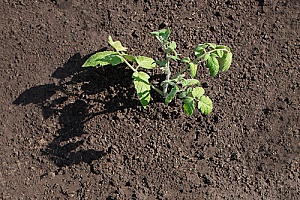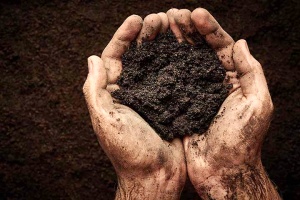Dirt such as topsoil is used for many different landscaping applications around a property. While knowing what type of dirt to use for your project is crucial, knowing the proper measurements and increments that it comes in is very helpful, as well. Topsoil generally comes in cubic yards, which almost always weighs an approximate amount.
Before going into how much a yard of topsoil weighs, let us first go over what topsoil is and what it is generally used for.
What is Topsoil?
Dirt is most often categorized into two main types: fill dirt and topsoil. Fill dirt is the dirt below topsoil, and usually has a low amount of organic material, consisting of rockier material.
Topsoil is the very top layer of dirt in the earth’s surface. This layer is usually around 4 to 12 inches deep from the surface, and consists of nutrients and organic matter. High quality topsoil often contains lots of carbon, nitrogen, and other helpful nutrients that directly contribute to better plant growth.
Topsoil is the best soil to use for planting and gardening. The increased amount of organic matter and nutrients provides more oxygen to the plants, facilitating healthy roots and added growth. Because of the increased amount of organic matter, topsoil does have a bigger propensity to break down due to the collapse of air pockets, so it is only suitable for the very top layer of landscaping, rather than being used as a supporting layer under solid structures and landscaping.
Additional items such as fertilizers and compost can be added to your topsoil to increase the amount of nutrients and oxygen inside of it. Topsoil can even be be converted into garden soil with enough composting and fertilizer additions, but the process can take months.
Regardless of what you do with it, topsoil should always be placed on top of fill dirt once it has been set, especially if you want your vegetation to flourish.
What Soil Type Do I Need?
 Choosing the right soil type for your project is crucial. Using the wrong soil type can result in a multitude of problems in both the short and long term.
Choosing the right soil type for your project is crucial. Using the wrong soil type can result in a multitude of problems in both the short and long term.
Fill Dirt
If you need to fill gaps, holes, and divots around a property, fill dirt is the way to go. This dirt can also be used to grade your property’s soil levels, create slopes and ditches, and also create a foundation to build upon.
Topsoil
Topsoil is always used on top of fill dirt, or in isolation in a planter or garden box. Uses include flowerbeds around your property, the top of the soil for grass planting, and for gardening as well. Using fill dirt in place of topsoil can result in malnourished plants that will either die, or fail to grow to their full potential.
How to Measure Topsoil
As mentioned earlier, topsoil most often comes in cubic yards, although smaller amounts can be purchased, often in bags measured in cubic feet.
1 cubic foot equals 12 inches x 12 inches x 12 inches, while 1 cubic yard equals 27 cubic feet. For reference, imagine an empty cube that has sides of 1 yard. Fill that empty cube up with soil, and you have a perfectly-packaged cubic yard of dirt.
Measuring out the dirt amount beforehand can be done in two different ways:
Using Method #1
This is how you would determine how much topsoil you would need for a flower bed that is 6″ deep and 12′ long by 12′ wide:
- Convert the dimension in inches to feet (6″ ÷ 12″ = 0.5′)
- Multiply the three dimensions together to find the number of cubic feet (0.5′ x 12′ x 12 = 72 cubic feet)
- Divide the cubic feet by the number of cubic feet in a cubic yard (27) to find the number of cubic yards (72 ÷ 27 = 2.67 cu. yd.).
Therefore, you would need 2.67 cubic yards of dirt to fill the flower bed.
Using Method #2
 Here is a different calculation for the same amount. This involves converting all three dimensions to yards:
Here is a different calculation for the same amount. This involves converting all three dimensions to yards:
- Convert the dimension in inches to yards (6″ ÷ 36″ = 0.167 yards)
- Convert the dimensions in feet to yards (12′ ÷ 3 = 4 yards)
- Multiply the three dimensions together to find the number of cubic yards (0.167 x 4 x 4 = 2.67 cu. yd.)
If you are not comfortable doing the calculations yourself, online dirt calculators are easy to find on any search engine.
Measurement Units
The yard, a unit of length in the imperial and U.S. customary systems, has become the standard measurement unit for topsoil due to its practicality and compatibility with the scale of landscaping projects. When we talk about measuring topsoil in yards, we are referring to cubic yards—a three-dimensional measure that considers the length, width, and depth of a given area.
This choice of unit aligns seamlessly with the nature of landscaping and gardening projects, where areas are often irregularly shaped. The cubic yard provides a holistic measurement that accounts for the entirety of the space, offering a comprehensive understanding of the volume of topsoil needed. It simplifies calculations, streamlining the process for both professionals and DIY enthusiasts alike.
Factors Influencing Topsoil Weight
Determining the weight of a yard of topsoil isn’t a straightforward arithmetic exercise. Instead, it’s a nuanced exploration that involves understanding a variety of factors that contribute to the overall density of this essential gardening material. Moisture content, organic matter, and composition variations emerge as key influencers, each adding its own layer of complexity to the weight calculation. Delving into these factors is crucial for anyone seeking to make informed decisions about topsoil procurement.
Moisture Content
Moisture is a significant variable when it comes to topsoil weight. The water content within the soil particles can significantly impact its density. A yard of moist topsoil will inevitably weigh more than the same volume of dry soil. This dynamic nature means that topsoil weight can fluctuate based on weather conditions, recent precipitation, or irrigation practices. Balancing the moisture content is a critical consideration, especially when precision is crucial for landscaping or gardening projects.
Organic Matter
The organic matter present in topsoil, derived from decomposed plant and animal materials, introduces another layer of variability to its weight. Organic matter is generally less dense than mineral components, meaning that topsoil with a higher organic content will be lighter by volume. However, the presence of organic matter contributes to the overall fertility and health of the soil, emphasizing the need for a balance between weight considerations and soil quality.
Composition Variations
Topsoil is not a uniform entity; its composition can vary widely based on factors such as geographical location and the source of the soil. Different types of topsoil, such as sandy, loamy, or clayey soils, have distinct compositions, and each comes with its own weight characteristics. For instance, sandy topsoil is generally lighter due to the larger particle size, while clayey soil tends to be denser. Understanding the specific composition of the topsoil being procured is essential for accurate weight estimations.
Additional Considerations
Beyond these primary factors, other considerations can influence topsoil weight. Compaction, a common occurrence in transported or stored topsoil, can increase its density. The presence of rocks or debris in the soil can also add weight, impacting both the transportation and application of the soil.
Average Weight of a Yard of Topsoil
 On average, a yard of dry unscreened topsoil typically weighs between 2,000 to 2,700 pounds. This range serves as a broad baseline, offering a sense of what to expect when calculating topsoil weight. However, it’s important to note that this is a generalization, and actual weights can vary based on a variety of previously mentioned factors such as moisture content, organic matter and type of fill dirt.
On average, a yard of dry unscreened topsoil typically weighs between 2,000 to 2,700 pounds. This range serves as a broad baseline, offering a sense of what to expect when calculating topsoil weight. However, it’s important to note that this is a generalization, and actual weights can vary based on a variety of previously mentioned factors such as moisture content, organic matter and type of fill dirt.
Tips for Handling and Transporting
Managing the weight and logistics of topsoil involves a series of considerations to ensure a smooth and efficient process. From handling the bulk weight of the soil to transporting it to the desired location, adopting best practices can make a significant difference in the success of landscaping or gardening projects
Proper Equipment Selection
Choose equipment with the right capacity: Before embarking on any topsoil project, ensure that the equipment, whether it’s a wheelbarrow, shovel, or machinery, can handle the weight and volume of the soil. Opting for equipment with the appropriate load-bearing capacity prevents unnecessary strain and potential injuries.
Moisture Management
Avoid excessive moisture: While moisture is crucial for the health of the topsoil, excessive wetness can significantly increase its weight. If possible, schedule topsoil handling during drier periods to minimize the risk of dealing with overly heavy soil.
Strategic Loading and Unloading
Distribute weight evenly: When loading topsoil onto trucks or other transport vehicles, distribute the weight evenly to ensure stability during transit. Similarly, when unloading, do so gradually and evenly to prevent sudden shifts in weight that could lead to accidents.
Proper Packing and Containment
Use appropriate containers: Utilize containers or bags designed for transporting topsoil. This not only helps in maintaining the soil’s integrity but also streamlines the loading and unloading process.
Collaboration with Professionals
Hire experts if needed for large-scale projects or challenging terrains, consider enlisting the services of professionals experienced in handling and transporting topsoil. Their expertise can streamline the process and ensure optimal results.
Get In Touch with Northern Virginia Dirt Professionals
As we conclude our exploration, we summarize the key points about the weight of a yard of topsoil. Emphasizing the importance of informed decision-making in topsoil-related projects, we invite readers to share their experiences and insights in the comments section.
Whether you’re embarking on a construction project, landscaping endeavor, or excavation task, our team is here to provide expert guidance and high-quality solutions. Contact Dirt Connections now – because when it comes to dirt, we’re the experts you can trust. Let’s build something great together!


